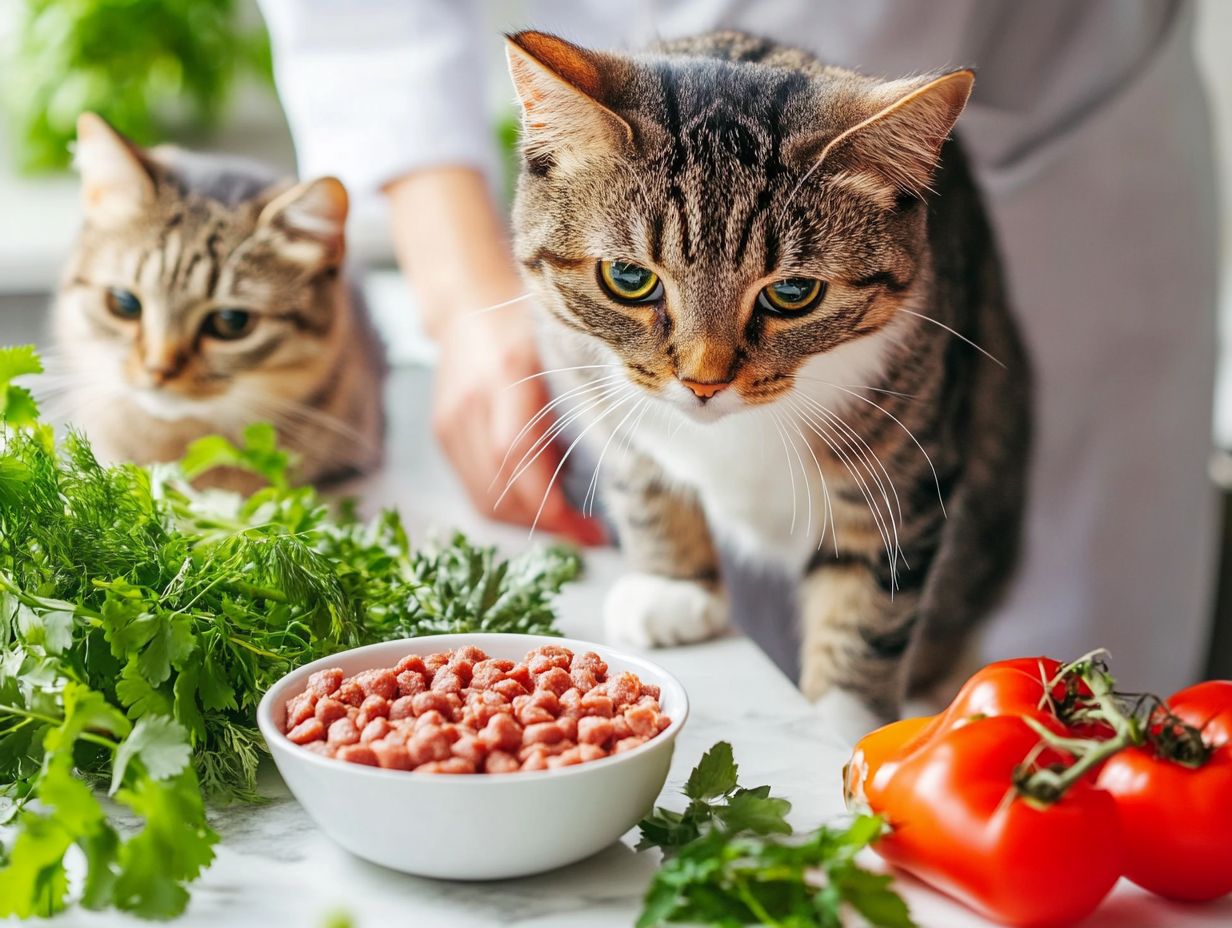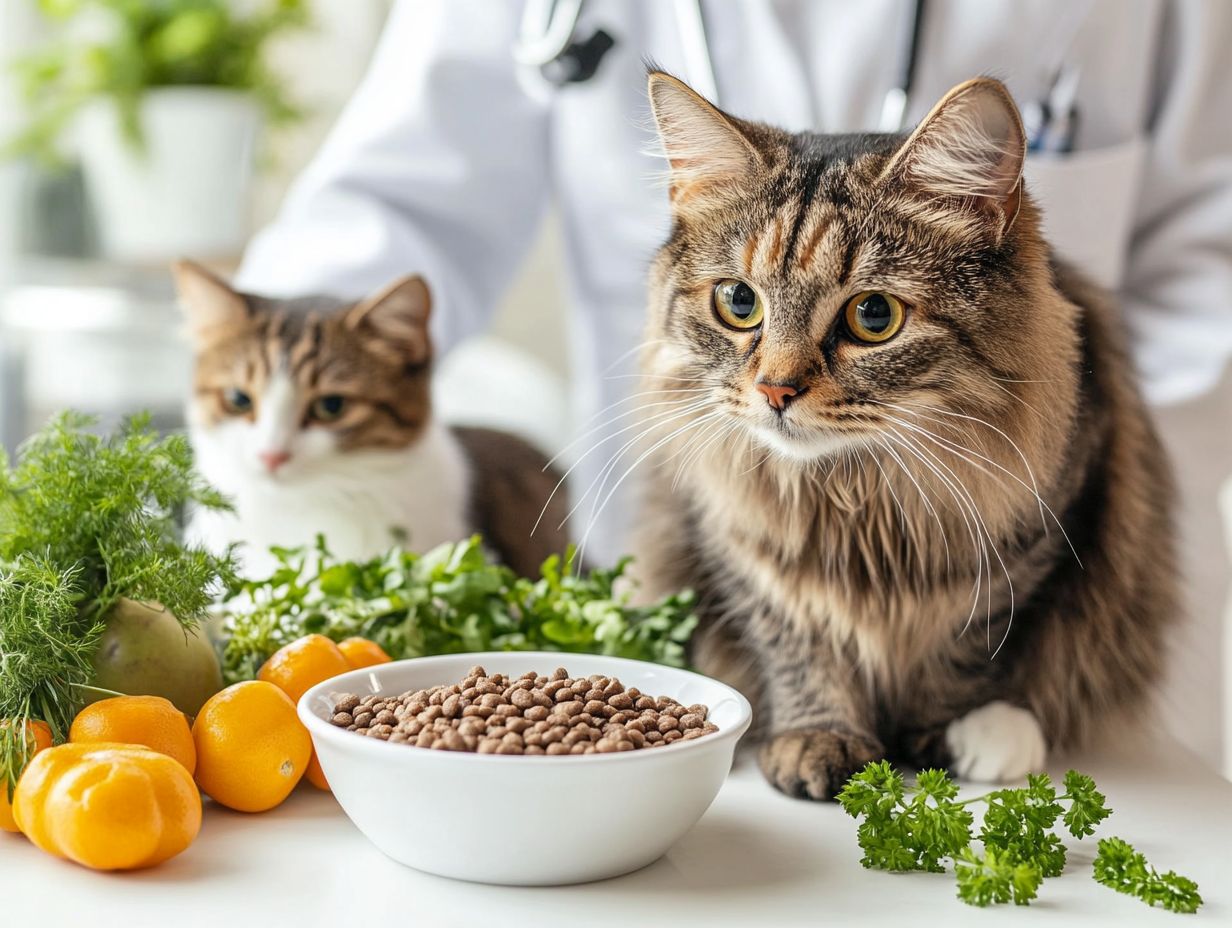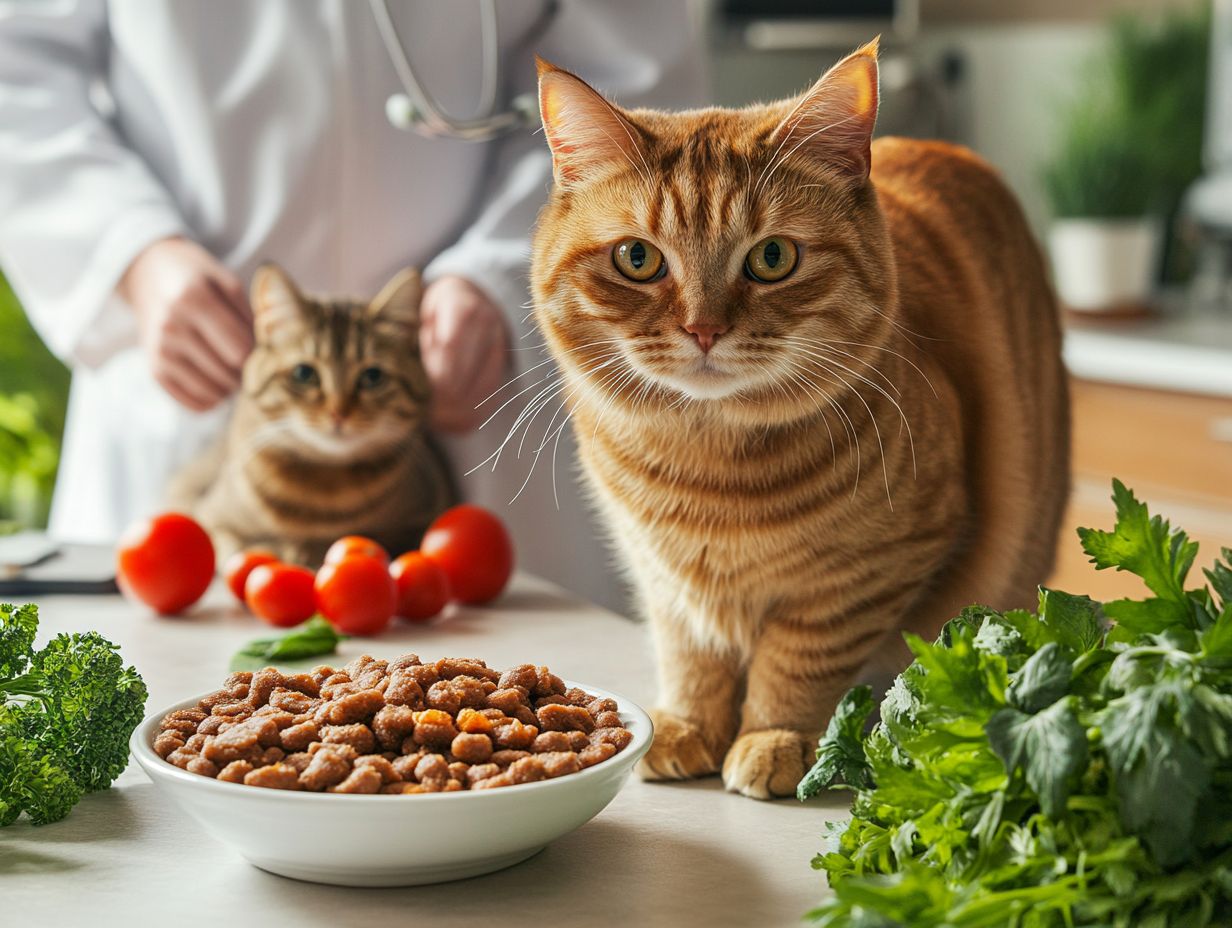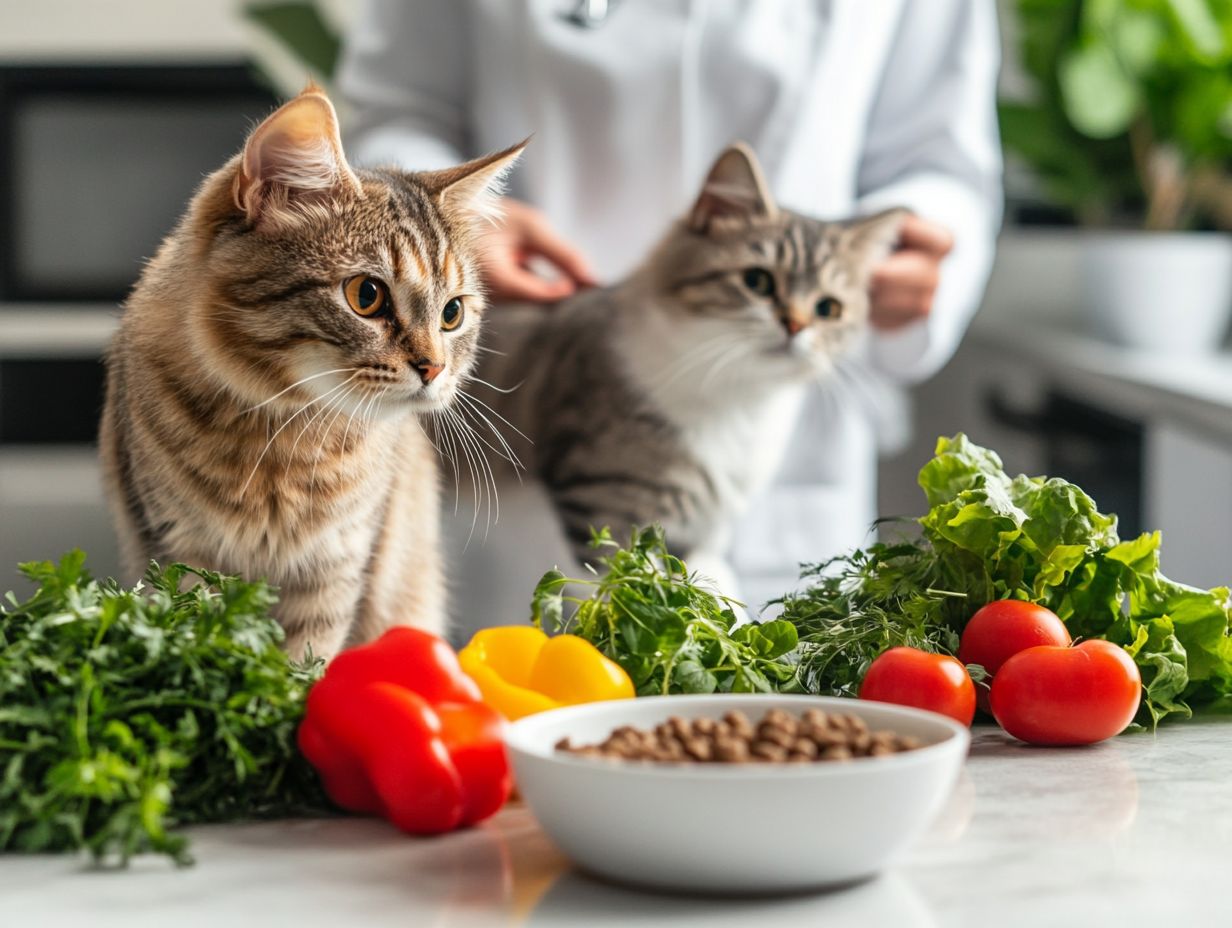Disclaimer: Before making any dietary changes for your cat, especially regarding raw diets, it is crucial to consult with a veterinarian to avoid potential health risks.
Feeding your cat a raw food diet can seem daunting, and while there are potential health benefits aligned with their dietary preferences, it’s crucial to understand the associated risks and the need for veterinary guidance.
From improved nutrition and gut health to a stronger immune system and better dental care, raw food can transform your feline’s health when guided by veterinary advice. However, it’s essential to weigh these advantages against the risks, like bacterial contamination, nutritional imbalances, and other safety concerns.
This article will guide you through the perks of raw cat food, the types available including commercial raw diets, and insights to help you make informed decisions for your furry friend.
Key Takeaways:

Why Should You Feed Your Cat Raw Food?
The health benefits of a raw food diet for cats stem from its alignment with their natural dietary needs as obligate carnivores. The animal protein found in raw meat is well-suited to cats and can contribute to their overall health.
A complete and balanced raw food diet enhances their well-being and offers protection against illness and disease by promoting optimal immune and digestive health, as noted by veterinarians and veterinary nutritionists.
For pet owners interested in feeding their cats a raw diet, it is essential to understand the nutritional history of cats and the balanced nature of raw food diets.
1. Better Nutrition for Cats
Many veterinarians consider a raw food diet to be a superior nutritional choice for cats compared to traditional commercial diets. This approach prioritizes high-quality animal protein, which is crucial for maintaining muscle mass and overall health. It also includes a range of bioactive compounds that support immune function and promote a healthy coat.
Research from institutions such as the University of Helsinki shows that raw diets can provide essential fatty acids, vitamins, and minerals that are often lacking in processed options. While some cat owners have concerns about potential nutritional deficiencies and safety, many veterinary associations advocate for a balanced raw diet, emphasizing the importance of carefully selected ingredients to meet all dietary needs.
2. Improved Digestion and Gut Health
Transitioning to a raw food diet can significantly improve digestion and gut health in cats, a benefit frequently emphasized by veterinarians. This dietary change is especially effective in addressing common issues such as bloating and constipation.
The natural enzymes present in raw meat assist in breaking down food more efficiently, while the high moisture content offers essential hydration to support digestive processes. Incorporating raw foods can also enhance gut flora, promoting a balanced microbiome that is vital for overall health.
Veterinarians often recommend a gradual transition to prevent digestive upset, suggesting an initial mixed approach to help cats comfortably adapt to the new diet.
3. Reduced Risk of Allergies and Food Sensitivities
Veterinarians specializing in pet nutrition suggest that a raw food diet for cats significantly reduces the likelihood of allergies and food sensitivities. Cats that consume raw meats, such as turkey, lamb, and rabbit, are less likely to encounter many common allergens found in commercial pet foods, which often contain fillers and artificial ingredients.
These meats are highly digestible and have a moderate to high allergen index, making them suitable alternatives for pets with sensitivities to more traditional protein sources. It is important to transition a pet to a raw diet under the guidance of a veterinarian to ensure that all nutritional needs are met and to avoid causing any digestive distress during the switch.
4. Prevention of Dental Issues
To maintain your cat’s dental health, it is crucial to consider the dietary choices you make. Regularly incorporating the right raw foods can contribute positively to dental hygiene.
Cats are obligate carnivores, which means they require a diet high in animal-source proteins to thrive. A raw food diet can help prevent dental problems in cats, a significant health concern that veterinarians often emphasize to pet owners. The natural chewing action from raw meat and bones reduces plaque buildup and strengthens teeth. However, claims about the efficacy of raw diets should be cross-verified against current veterinary nutrition standards, including citations from authoritative sources like AAFCO and WSAVA.
This form of natural dental care is essential for cleaning the surfaces of their teeth and stimulating the gums. Additionally, animal protein in the diet supports gum health, which is crucial for maintaining the strength of the structures that hold the teeth in place.
To ensure optimal dental health, regular visits to the veterinarian are important, as they can provide tailored dietary recommendations and preventive measures. It’s vital to note that raw diets may also present potential nutritional deficiencies, including levels of taurine and calcium sources that should be closely monitored.
5. Promotes Healthy Weight and Muscle Mass

A raw food diet can promote healthy weight and muscle mass in cats—two factors that veterinarians consider essential for their overall health and well-being. This dietary approach is rich in high-quality proteins that support muscle growth and development, helping to maintain an ideal body condition. Pet owners should reference current guidelines on feline obesity management and weight control, aligning it with appropriate portion sizes based on a cat’s age, activity level, and health status to ensure a balanced diet.
By providing appropriate amounts of protein, pet owners can assist their cats in achieving optimal muscle tone while effectively managing their weight. Additionally, maintaining a regular feeding schedule helps regulate metabolism, allowing the body to utilize nutrients as efficiently as possible. Adhering to these guidelines promotes optimal health and contributes to a happier, more energetic quality of life for cats.
6. Supports a Strong Immune System
Veterinarians agree that a raw food diet for cats can strengthen their immune system and enhance their resistance to disease. This diet is rich in bioactive compounds, including amino acids, fatty acids, and vitamins, which are crucial for maintaining a cat’s health.
For instance, taurine and omega-3 fatty acids are essential nutrients that improve cellular function and reduce inflammation. Additionally, vitamin E and selenium, found in red blood cells, play a vital role in supporting optimal immune responses. Pet owners can assess their cat’s health on a raw diet by observing changes in energy levels, coat condition, and overall digestion. Regular veterinary visits, along with blood tests, are effective ways to clinically and objectively evaluate the diet’s effectiveness and ensure that their pet remains healthy while on this diet.
7. Increased Energy and Vitality
Cats that are fed a raw food diet often exhibit increased energy and vitality, a positive change frequently observed by their owners. This boost in energy is believed to result from the natural composition of the diet, which contains significantly higher levels of proteins and other nutrients that are more easily digested and absorbed.
While anecdotal evidence exists, it is essential to support claims with scientific data. A recent study revealed that cats transitioning from commercial kibble to a raw diet showed improvements in agility and alertness. One owner shared that her previously lethargic tabby became more lively and active, enthusiastically chasing toys and engaging with family members. Such evidence highlights the significant differences in overall well-being observed in cats on raw diets compared to those consuming highly processed foods.
What Are the Risks of Feeding Your Cat Raw Food?
Pet owners should be aware of several risks associated with feeding cats a raw food diet, including the potential for Salmonella, Listeria, and other harmful bacteria. It is crucial to discuss these risks with a veterinarian before making diet changes.
1. Bacterial Contamination
The primary risk of feeding cats a raw food diet is bacterial contamination, particularly from pathogens such as Salmonella and Listeria. These harmful bacteria can be introduced through contaminated raw meat, dirty surfaces, or improper storage practices. Pet owners must ensure that the raw ingredients they use are sourced from reputable suppliers and stored properly in the refrigerator.
It is essential to thoroughly sanitize the preparation area before and after handling raw food to minimize the risk of cross-contamination. Additionally, pet owners should be informed about allergen safety and toxic ingredients associated with raw diets, providing clear examples of what to avoid and why.
Tailoring Raw Diets for Special Needs
Raw diets can be tailored for cats with specific health conditions like kidney disease or diabetes, ensuring accurate nutrient profiles are maintained. Consult with a veterinarian to make necessary adjustments based on individual health needs.
Life Stage Considerations
It is important to address the unique nutritional needs of different life stages (kittens, senior cats, pregnant/nursing cats) within the context of raw diets to ensure balanced nutrition throughout their lives.
Additionally, pet owners can further protect their cats by washing their hands and using separate cutting boards and utensils specifically for pet food. Veterinarians are valuable resources for developing safety measures and dietary guidelines to ensure a balanced and safe feeding plan. Always consult a veterinarian for personalized advice.
2. Nutritional Imbalances
One risk associated with raw food diets for cats is the potential for nutritional imbalances, which can occur if the diet is not properly formulated to be complete and balanced. Deficiencies in essential nutrients, such as taurine, can lead to serious health issues, including heart disease.
For pet owners interested in this feeding method, it is crucial to understand that cats have specific nutritional requirements that must be adequately met to maintain their health and well-being. This includes, but is not limited to, essential nutrients such as taurine, vitamins, and minerals.
Consulting a veterinarian is essential to ensure that a raw food diet meets a cat’s dietary requirements and is suitable for the individual cat’s health needs. Such veterinary advice can help pet owners avoid common mistakes and prevent adverse health effects, including potential food allergies and dietary indiscretion.
3. Potential for Bones and Choking Hazards

Feeding cats raw food that contains bones presents potential choking hazards and other risks, a fact that veterinarians consistently warn against. While some types of bones, such as raw chicken necks or wings, are soft enough for cats to chew and digest safely, others, particularly cooked bones, pose serious health risks due to their tendency to splinter, which can lead to blockages or tears in the digestive tract.
Not all bones are safe for feline consumption. Those who wish to include bones in their cats’ diets may want to consider bone meal or commercially prepared raw diets that are appropriately balanced and manufactured with safety in mind. To ensure safety, avoid feeding hard, cooked bones and consult with veterinarians about safe practices.
Additionally, observing feeding patterns and being vigilant about any adverse reactions can help determine the best dietary choices for each individual animal. Always be cautious about portion sizes and caloric intake to prevent obesity.
What Types of Raw Food Can You Feed Your Cat?
Cats following a raw food diet can be provided with either pre-made raw food or homemade raw meals.
1. Pre-made Raw Food and Commercial Raw Diets
Pre-made raw food allows pet owners to easily provide their cats with a balanced raw diet without the need for preparation. This convenient solution also mitigates safety concerns, as responsible brands implement safety procedures, including pathogen testing and proper sourcing, to minimize contamination, including with Salmonella and Listeria.
These products offer nutritional benefits, as they are crafted by nutritionists and veterinarians while adhering to guidelines set by the American Association of Feed Control Officials (AAFCO) and the World Small Animal Veterinary Association (WSAVA) Nutritional Guidelines. For further insights, refer to reputable sources like the Pet Food Ingredient Center and Pet Food Reviews.
However, pet owners should be aware of some drawbacks, including the high cost and the need for special storage and handling to ensure that the meals remain safe and effective for their cats. Proper storage practices are critical to prevent spoilage and contamination.
2. Homemade Raw Food
Homemade raw food can be an appealing option for pet owners who wish to have complete control over their cat’s diet; however, it requires careful planning to ensure nutritional balance. It is important to consult with veterinarians to receive tailored advice and recipes that cater to individual health needs.
To achieve this balance, it is essential to incorporate a variety of meats, organs, and bones, while also considering the necessary vitamins and minerals. Cat owners must understand that nutrition involves not just the ingredients but also how they are prepared and stored to maintain freshness and prevent contamination.
Improper preparation can lead to risks of bacterial contamination and spoilage. Safety is paramount; appropriate preparation techniques must be followed to ensure a healthy meal that supports a cat’s overall well-being. Consider ethical sourcing of ingredients and sustainability when choosing products.
What Are the Best Raw Food Brands for Cats?
Some of the best raw food brands for cats include Instinct, Stella & Chewy’s, Primal Pet Foods, and Feline Natural, among others. Selecting the right brand is crucial and can be challenging; an incorrect choice may jeopardize a cat’s health, while the right one can support overall well-being.
The best brands offer a complete and balanced diet that enhances health and vitality, and they are often endorsed by veterinarians and veterinary associations. These brands typically feature high protein content from real meat, along with organic fruits and vegetables, and are formulated by veterinary nutritionists.
They also hold certifications such as FSMA compliance, USDA approval, and AAFCO compliance, which demonstrate their commitment to safety and quality. These brands often apply high pressure processing to ensure that the raw meat is safe for consumption. Pet owners should conduct thorough research to understand the nutritional profiles and sourcing practices of the brands available, including those like Instinct Raw.
What Do Vets Say About Raw Cat Food?
Veterinarians hold a range of opinions about raw cat food, often highlighting both the potential benefits and risks. A complete and balanced diet is essential to ensure the health of pets, and consulting professionals is advised.
1. Pros and Cons of Raw Cat Food

The advantages and disadvantages of raw cat food are often debated among veterinarians and pet owners. Supporters of raw diets argue that they lead to better digestion, shinier coats, and are more biologically appropriate for cats, providing essential bioactive compounds.
Dr. Lisa Pearson, a veterinary nutritionist, advocates for raw diets, stating, “Cats require a high-protein, carnivorous diet, something that raw food provides, thereby supporting immune function and overall pet health.”
However, the disadvantages of raw cat food should not be overlooked. These include the risks of bacterial contamination and potential nutritional imbalances if the diet is not properly formulated. A study published in the Journal of Veterinary Internal Medicine found that unsupervised raw feeding practices could lead to serious health complications, underscoring the importance of consulting with qualified professionals before making the switch.
Veterinary guidelines recommend monitoring the health of cats on raw diets closely, as improper feeding practices have been linked to increased risks of foodborne illnesses and nutrient deficiencies.
2. Tips for Feeding Your Cat a Balanced Raw Diet
Feeding your cat a balanced raw diet requires careful planning and guidance, with veterinarians providing essential recommendations to ensure nutritional adequacy. Owners can successfully transition their cats to a raw food diet by following these steps:
- Incorporate Raw Food Gradually: Begin the transition by slowly introducing raw pet food into your cat’s current diet. This gradual approach helps your cat adjust to the new diet and allows you to monitor any digestive issues that may arise, including risks of Salmonella or Listeria.
- Correct Portion Sizes Matter: Pay attention to portion sizes, as they are critical for maintaining your cat’s health. Portions that are too large can lead to excess weight, while those that are too small may not provide sufficient energy.
- Include Varied Protein Sources: It is important to incorporate a variety of animal protein sources in your cat’s raw food diet, such as chicken, beef, turkey, lamb, and fish. This variety helps ensure that your cat receives a complete and balanced diet, reducing the risk of nutritional deficiencies.
- Seek Guidance from a Veterinarian: Consult with a veterinarian to refine your cat’s diet further. They can provide nutritional consultations to adjust meal plans, address specific changes based on your cat’s nutritional history, and help monitor progress throughout the transition process. Consider veterinary associations for additional support.
Additionally, it is important to consider age-specific nutrient profiles for different life stages (kittens, seniors, pregnant or nursing) while transitioning to a raw diet. Supplements may also be necessary to meet specific dietary needs.
Proper food storage and handling practices are essential for raw diets. Always check for spoilage and follow safe handling guidelines to help prevent foodborne illnesses.
The University of Helsinki has conducted studies supporting the health benefits of raw diets for cats, emphasizing the importance of consulting with qualified professionals.
Frequently Asked Questions
What are the 7 surprising benefits of raw cat food?
According to vet-backed research, the 7 surprising benefits of raw cat food include improved digestion, healthier skin and coat, stronger immune system, healthier teeth and gums, better weight management, increased energy and vitality, and reduced risk of chronic diseases, supporting overall pet nutrition and health.
How does raw cat food improve digestion?
Raw cat food may be easier for some cats to digest compared to processed food, as it contains natural enzymes and beneficial bacteria that can aid in the breakdown of food. However, it’s important to note that some cats might experience gastrointestinal upset. Monitoring individual responses and consulting with a veterinarian before making dietary changes is crucial.
Can raw cat food help with skin and coat health?
Yes, raw cat food often contains essential fatty acids and nutrients that may promote healthier skin and coat. However, the overall balance of nutrients is critical, and not all raw diets are formulated to meet the specific needs of all cats, particularly those with certain health conditions.
Why is a stronger immune system important for cats?
A strong immune system is crucial for cats as it helps protect them from various illnesses and diseases. While raw cat food can provide vital nutrients and antioxidants that may boost the immune system, it’s essential that the diet meets the nutritional adequacy standards set by AAFCO guidelines to support overall health.
How does raw cat food contribute to dental health?
The chewing action required to eat raw cat food may help clean the teeth and massage the gums, promoting better dental health. However, dental health also requires regular veterinary care. Additionally, not all raw food is created equal in terms of dental benefits, so it’s important to ensure the chosen diet supports oral health.
Is raw cat food suitable for cats of all ages?
While raw cat food can be suitable for cats of all ages, special diets may be necessary for cats with specific health needs or conditions, especially in senior cats or those with underlying health issues. It’s advisable to consult with a veterinarian for personalized dietary advice, particularly for kittens, senior cats, and pregnant or nursing cats, as their unique dietary requirements must align with current veterinary nutrition standards.
Food Safety Practices
When handling raw cat food, it’s vital to practice safe preparation methods to prevent foodborne illnesses. This includes proper storage, identification of spoilage, and thorough cleaning of all surfaces and utensils used during preparation.
Ethical and Sustainability Considerations
In addition to health benefits, pet owners should consider the ethical and sustainability implications related to sourcing animal proteins. Encouraging responsible pet ownership and environmentally conscious choices is important for the well-being of both pets and the planet.